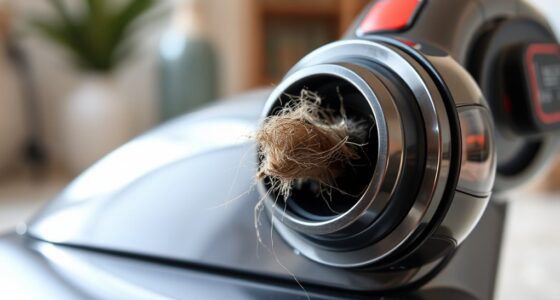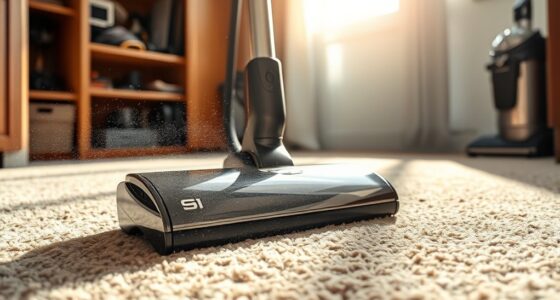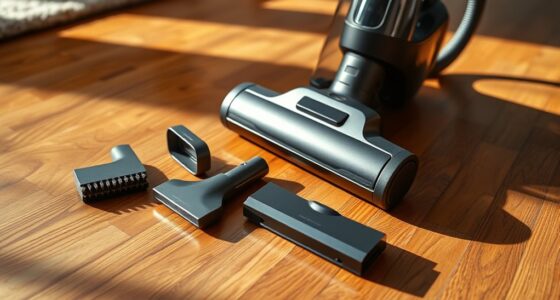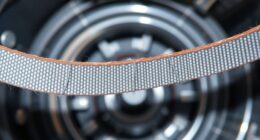To keep your vacuum working efficiently, replace the bag when it’s about 70–80% full. Waiting too long can reduce suction, strain the motor, and lower cleaning performance. Regularly check the bag’s fill level and change it promptly to avoid these issues and extend your vacuum’s lifespan. Knowing the right time for replacement helps maintain ideal operation. If you want to learn how to do it safely and properly, there’s more useful information ahead.
Key Takeaways
- Replace the vacuum bag when it reaches 70–80% full to maintain suction and cleaning efficiency.
- Regularly check the bag’s fill level to prevent strain on the vacuum’s motor.
- Waiting until the bag is full can reduce suction power and damage the vacuum over time.
- Prompt replacement at 70–80% fill prolongs vacuum lifespan and ensures optimal performance.
- Handle and dispose of the full bag carefully to avoid dust escape and maintain a clean environment.
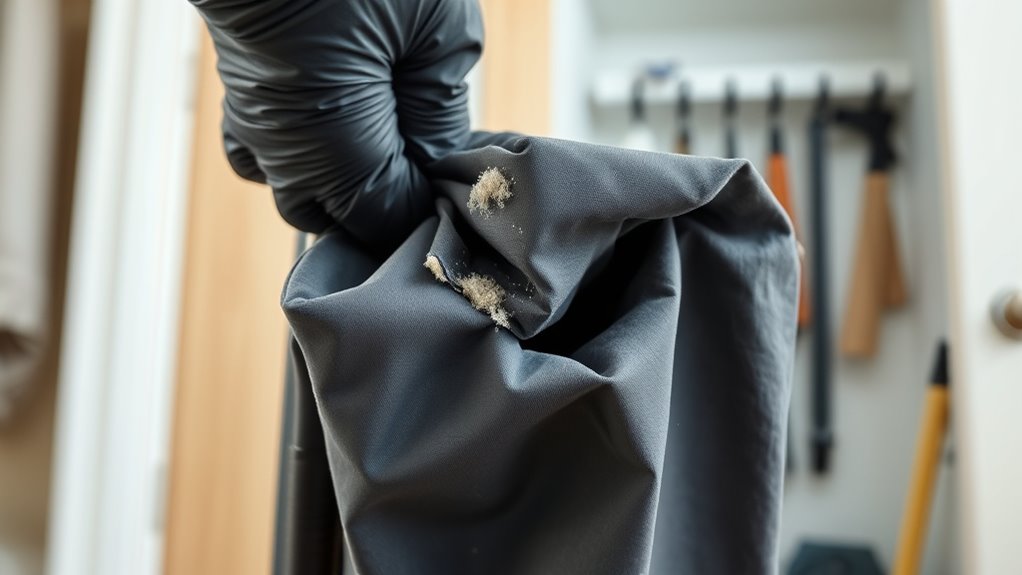
Replacing vacuum bags is a simple yet essential task to guarantee your vacuum cleaner performs at its best. When your bag reaches about 70–80% full, it’s time to contemplate replacing it, because a nearly full bag can hinder suction power and reduce cleaning efficiency. You might think that waiting until the bag is completely full is fine, but doing so can strain your vacuum’s motor and decrease its lifespan. Keeping an eye on the fill level and replacing the bag promptly ensures ideal performance and prolongs the life of your appliance.
The first thing you want to consider is the bag material. Different vacuums use various types of bags, such as paper, cloth, or synthetic materials. Each has its own advantages: paper bags are affordable and disposable, while cloth or synthetic bags are often reusable and more durable. Knowing what kind of bag your vacuum uses helps you choose the right replacement and handle it correctly. When replacing the bag, make sure to handle it carefully to avoid tearing or releasing dust into the air. Always wear a mask if you’re sensitive to dust or allergens, and dispose of the old bag properly.
Disposal methods are just as important as selecting the right bag. When it’s time to change the bag, seal it securely to prevent dust from escaping. Many bags come with a built-in closure or a simple flap that you can close before removing it from the vacuum. Once sealed, dispose of the bag in your household trash. If you’re environmentally conscious, check whether your local waste management accepts vacuum bags for recycling or special disposal. Avoid dumping the bag outside or in compost, as it might contain dust, dirt, or allergens that aren’t suitable for the environment. Proper disposal not only keeps your home clean but also helps reduce waste and keeps dust and allergens contained. Additionally, being aware of the filter and bag maintenance can help improve your vacuum’s overall efficiency and longevity.
Frequently Asked Questions
How Often Should I Replace My Vacuum Bag?
You should replace your vacuum bag when it’s about 70-80% full for ideal vacuum maintenance. Don’t wait until it’s completely full, as a fuller bag can reduce suction and strain the motor. Check the bag regularly, especially if you notice a decline in cleaning performance. Replacing it on time ensures your vacuum runs efficiently and prolongs its bag lifespan, saving you from costly repairs or replacements later on.
Can I Use a Different Brand of Vacuum Bag?
Yes, you can use a different brand of vacuum bag, but check for brand compatibility first. Confirm the bag material matches your vacuum’s requirements for peak performance and filtration. Using incompatible bags might cause leaks or damage your vacuum. Always read your vacuum’s manual to confirm which brands and materials are suitable. Sticking to recommended options helps maintain suction power and prolongs your vacuum’s lifespan.
What Are the Signs My Vacuum Bag Needs Replacing?
Like a vintage radio losing its tune, your vacuum bag signals when it’s time for a change. You’ll notice a decrease in dust capacity, making cleaning less effective. The bag material may also look full, torn, or clogged. If airflow feels restricted or the vacuum sounds louder, it’s a sign you should replace the bag. Regularly checking these signs guarantees your vacuum continues to perform at its best.
Is It Necessary to Replace the Vacuum Bag at 70-80% Fullness?
Yes, you should replace your vacuum bag at 70-80% capacity for ideal performance. Waiting longer can reduce suction, strain your vacuum motor, and allow dust to escape back into the air. By replacing it at this point, you maintain effective cleaning and protect your vacuum’s longevity. Regularly checking the vacuum bag capacity helps you identify the best timing for replacements, ensuring your vacuum runs smoothly and efficiently.
How Do I Dispose of Used Vacuum Bags Properly?
Proper disposal of used vacuum bags is vital for caring for your community and the climate. You should securely seal the bag and then place it in your regular trash. Look for vacuum bag recycling programs or environmentally friendly disposal options in your area. By doing so, you prevent pollutants from spreading and promote sustainability, turning trash into a responsible, resourceful act and keeping your home and earth clean and clear.
Conclusion
Remember, replacing your vacuum bag before it’s completely full is like giving your machine a fresh breath of life. When it’s 70–80% full, it’s like a storm brewing—too much dust can cause chaos and reduce performance. So, stay ahead of the mess, change the bag promptly, and let your vacuum glide through your home like a breeze. Keep it clean, keep it running smoothly, and enjoy the effortless dance of a spotless space.

